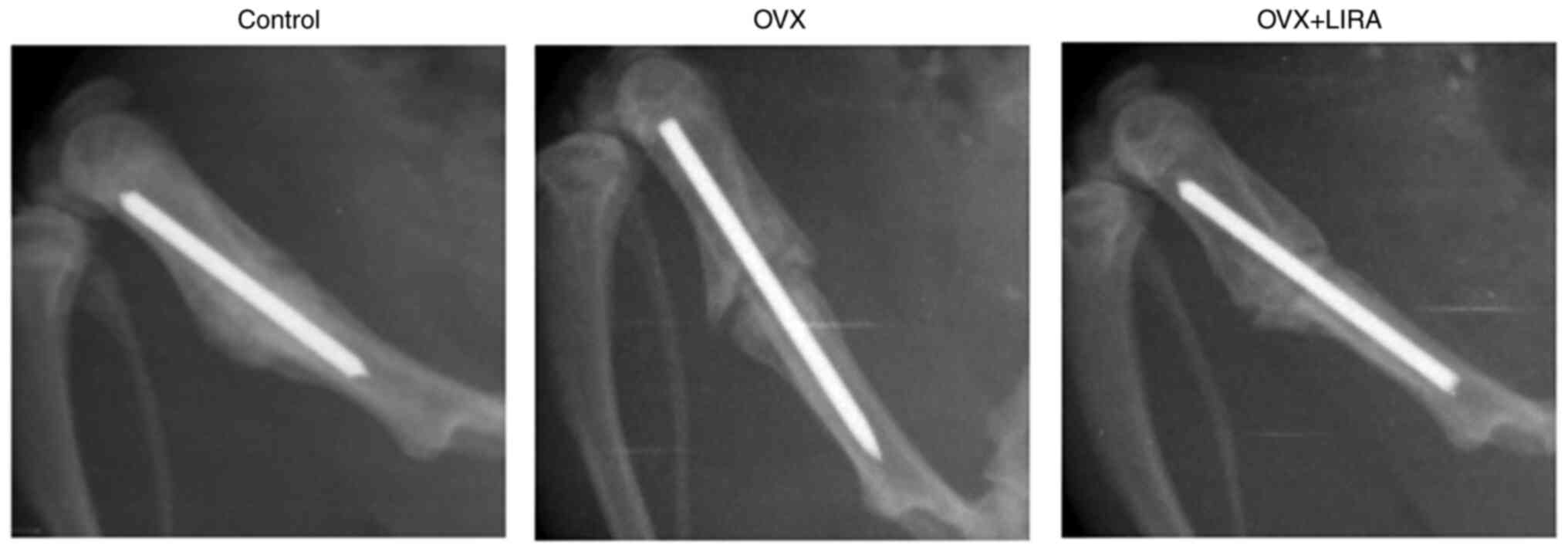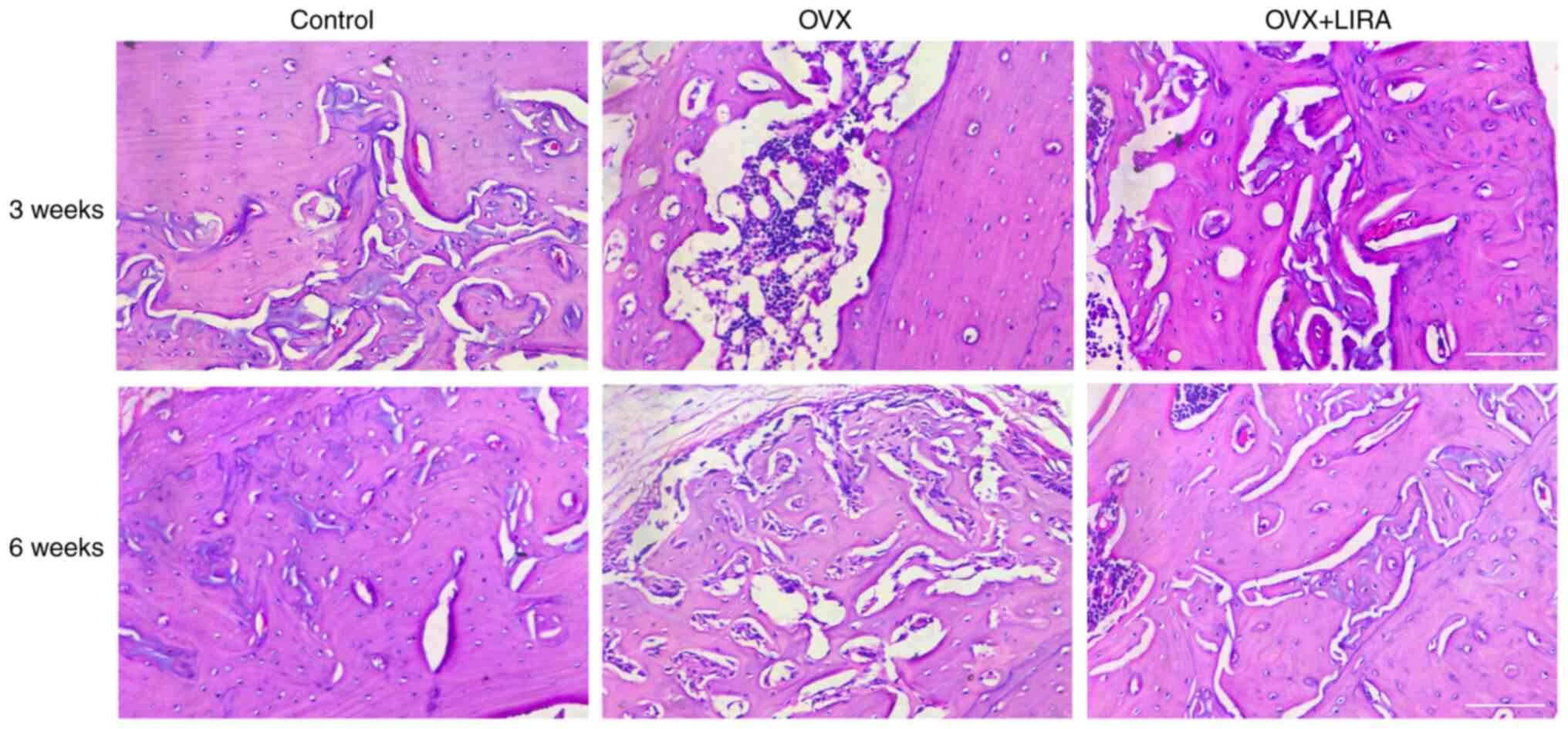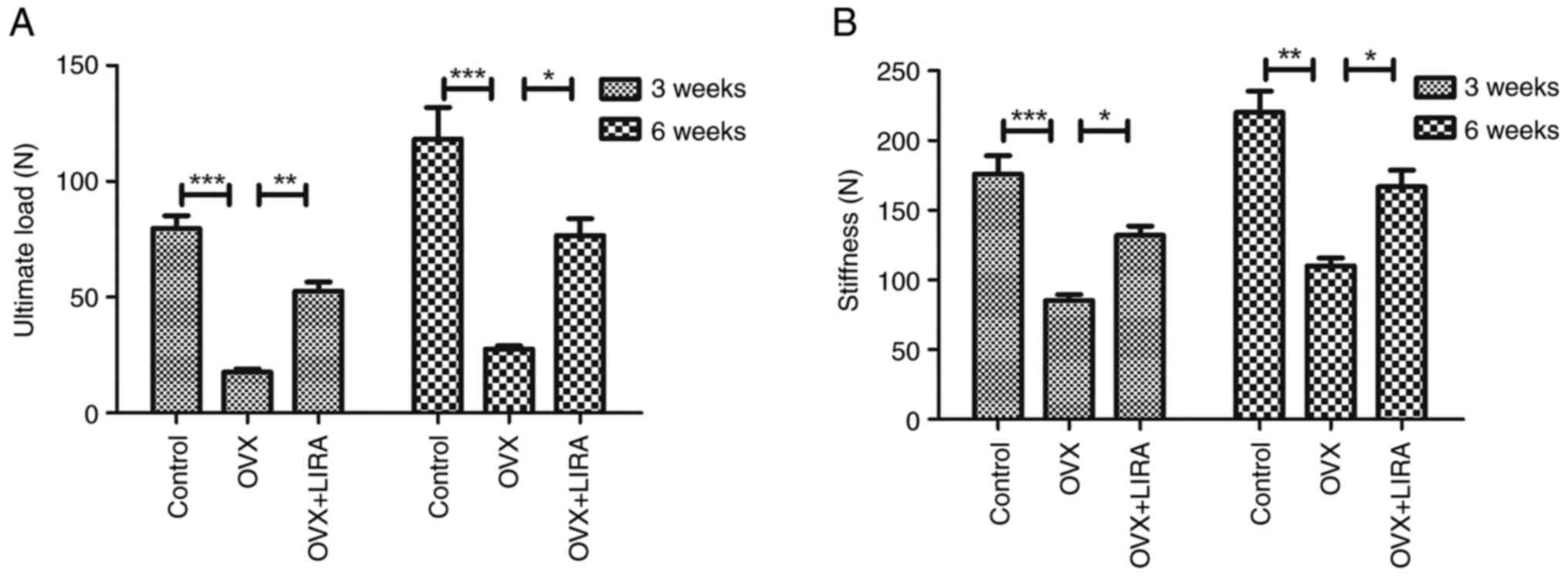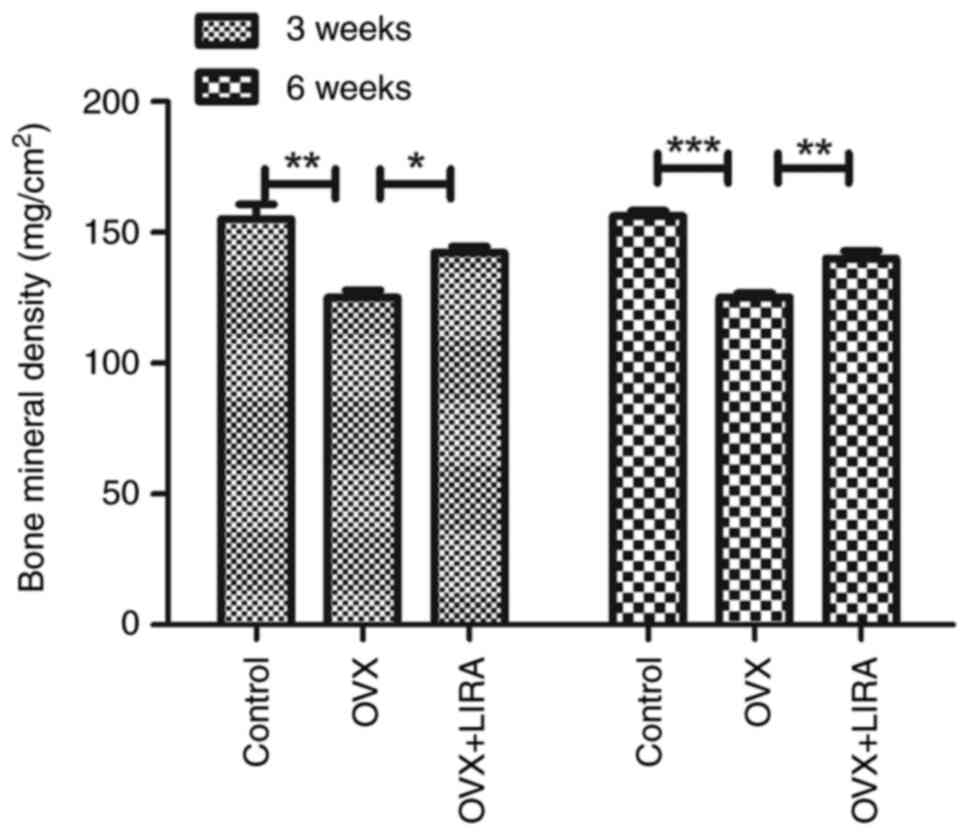Effects of glucagon‑like peptide‑1 receptor agonists on fracture healing in a rat osteoporotic model
- Authors:
- Published online on: July 11, 2023 https://doi.org/10.3892/etm.2023.12111
- Article Number: 412
-
Copyright: © Wang et al. This is an open access article distributed under the terms of Creative Commons Attribution License.
Abstract
Introduction
Osteoporosis (OP) is a common disease characterized by reduced bone mass, microstructural deterioration, fragility and consequent fragility fractures and is particularly prevalent among the elderly population (1). Osseous metabolic imbalance is the major pathogenic factor involved in OP; it is affected by diet, physical activity and clinical and hormonal states (2,3).
The aforementioned conditions associated with OP are significantly more common in patients with type 1 and 2 diabetes mellitus (DM) (4,5). Studies have shown that patients with DM have fragile bones, despite normal bone mineral density (BMD) (6,7). Type 2 DM patients have increased circulating levels of sclerostin, an osteocyte-secreted negative regulator of bone formation (8). The mechanisms underlying bone fragility in DM remain to be elucidated; however, aggregation of advanced glycation end-products, altered collagen cross-linking and reduced osseous turnover may serve a role (9). In addition to the intrinsic effects of DM on bones, several anti-diabetic drugs negatively affect bone health. For instance, thiazolidinediones increase the risk of fractures (10).
Previous research has shown that glucagon-like peptide-1 receptor agonists (GLP-1 RAs), which are novel incretin therapy-based anti-diabetic drugs, increase insulin secretion, promote insulin sensitivity and reduce gastrointestinal motility (11). The GLP-1 RA exenatide has positive effects on bones (12).
GLP-1 RAs may alter the bone turnover rate (13). GLP-1 indirectly inhibits bone resorption by binding to GLP-1 receptors (GLP-1Rs) within thyroid C cells and stimulating calcitonin production (14). In addition, mice with pancreatic GLP-1R deletion develop cortical osteopenia and increased calcitonin pathway-mediated bone resorption (15). A study found that GLP-1R activation positively affects bone quality and strength, whereas GLP-1R-deficient mice have significantly reduced bone mechanical strength, outer diameter and cortical thickness of bones and collagen matrix maturity (16). Additionally, mice with double incretin receptor knock-out have substantially altered bone strength and microarchitecture, suggesting that incretin hormones are essential for normal bone quality (17). The present study evaluated the effects of GLP-1RA on fracture healing in a rat model of variectomized OP (OVX).
Materials and methods
Animal model and pharmaceutical treatment
The 5-month-old Sprague Dawley female rats (n=36; weight: 280-320 g) were obtained from the Animal Center of Chinese Academy of Sciences (Shanghai, China). The rat experiment was performed in accordance with the guidelines of the Animal Care and Use Committee of Hainan Medical University (approval no. 2020-56). The animals were maintained at 25˚C in a temperature-controlled room with 40-50% humidity and free access to water and food. The rats were subjected to 1-week environmental acclimation under a 12-h light/dark cycle. The rats were randomly divided into the sham operation (control), OVX and OVX + LIRA groups. After inducing general anesthesia with an intraperitoneal injection of pentobarbital sodium (50 mg/kg), an incision was made on the back of mice to perform bilateral OVX. Then, the skin, abdominal cavity and muscles were cut using a 1.5-cm incision to expose the ovaries. Silk suture was used to ligate the oviduct. Next, bilateral OVX was performed. The remaining rats underwent a sham operation and examination of bilateral ovaries. The remaining steps were completed using an identical protocol for all groups. The BMD in the tibial metaphysis was tested to evaluate for the development of OP. Unilateral transverse osteotomy was performed in OP model rats in the right femur center and a 1-mm intramedullary nail [Wego Healthcare (Shenzhen) Co., Ltd.] was used for pinning. The solution of LIRA and saline (0.3 mg/kg/day) was injected subcutaneously around the back wound in OVX + LIRA rats until sacrifice (18). In the remaining rats, same quantity of saline was injected subcutaneously.
X-ray
At 3 and 6 weeks postoperatively, anteroposterior X-ray of the rat femur was performed to evaluate fracture union and bone formation using a small animal imaging system (12 sec; 26 kV; MX20; Faxitron X-Ray LLC).
Histological analysis
At 3 and 6 weeks postoperatively, 4% paraformaldehyde was added to fix the samples at 48˚C for a day. The tissues were subjected to decalcification for 2 days, dehydration using a graded ethanol series and embedding in paraffin. The tissues were sliced into 5-µm sagittal sections for hematoxylin & eosin (HE) staining. Light microscopy was used to analyze the histological images and Image-Pro Plus Software (Media Cybernetics, Inc.) was used for quantitative analysis. The sagittal cross-sectional area, callus thickness and callus area on the histological images were also assessed (19). In accordance with the tartrate-resistant acid phosphatase (TRAP) staining reagent protocols, the TRAP incubation solution was added to water-deparaffinized paraffin sections for 30 min incubation at 37˚C. The sections were washed using distilled water and treated with 2-amino-2-methyl-1,3-propane-diol-HCl solution (pH 9.4) for 10 min. Then, methyl green was added to stain the paraffin sections. The stained sections were washed using distilled water, dried and sealed. An inverted optical microscope (magnification, x40) was used to select the field of view and analyze the images. ImageJ software (Version 1.52e; National Institutes of Health) was used to determine osteoclast (OC) number per unit area of every TRAP-stained film. Each assay was performed three times and the average value was recorded. The OC cytoplasm and nucleus were stained wine red and light green, respectively.
Biomechanical examination
A three-point bending test (Instron 4302; Instron) was performed to evaluate the biomechanical properties of fracture healing at 3 and 6 weeks postoperatively. In brief, the femur was mounted on two loading bars (spacing: 18 mm), whereas the central callus was compressed using the mobile head at a compression velocity of 2 mm/min until fracture. A material testing machine was used to determine the ultimate load (N) and stiffness (N/mm) based on a load-deformation curve (20).
Statistical analysis
Data are presented as means ± standard deviation (SD) and analyzed using SPSS software (version 19.0; IBM Corp.). Differences between groups were analyzed using one-way analysis of variance and Tukey's post hoc test. P<0.05 was considered to indicate a statistically significant difference.
Results
X-ray evaluation of the effects of GLP-1R activation
X-rays were performed at 6 weeks postoperatively to determine the effects of GLP-1R activation on callus formation and bone union. The control group exhibited callus formation and bone union, while the OVX group exhibited fractional callus formation and incomplete bone union. Bone remodeling was promoted by the OVX + LIRA (Fig. 1).
Histological analysis of the effects of GLP-1R activation
HE staining of the histological sections was performed at 3 and 6 weeks postoperatively to analyze callus formation (Fig. 2). At 6 weeks postoperatively, compared with the OVX group, the control group exhibited greater bone cell growth and differentiation and regularly arranged bone trabeculae and collagen fibers. Tissue samples from the OVX + LIRA group exhibited broad bone trabeculae and rich cement lines compared with the control group. Similar findings were observed in the OVX group compared with the control group.
Quantitative analysis of fracture calluses
The quantitative analysis showed that the control group had greater sagittal femoral cross-sectional area compared with the OVX group at 3 and 6 weeks postoperatively, whereas the OVX + LIRA group showed a further increase in the area compared with the other groups (Fig. 3A). Similar findings were observed for callus area and thickness (Fig. 3B and C).
In vivo inhibition of OC generation by LIRA
At 3 weeks postoperatively, histological sections of the OVX group exhibited large multinucleated OCs. However, the OVX + LIRA group exhibited a markedly lower OC count compared with the OVX group (Fig. 4).
Biomechanical tests for the role of GLP-1 Ras
The three-point bending test was performed to evaluate the biomechanical strength of femoral cortical bone. Compared with the OVX group, the OVX + LIRA group had greater stiffness and ultimate load, which strengthened the femoral diaphysis of OP fracture rats at 3 and 6 weeks postoperatively (Fig. 5).
Effects of GLP-1 RAs on BMD
The present study measured the trabecular bone BMD in dismal femur. At 3 and 6 weeks after the fracture, the OVX group exhibited a lower trabecular BMD than the control group, whereas LIRA substantially restored the femoral trabecular BMD Compared with the OVX group (Fig. 6).
Discussion
OP may be caused by increased bone resorption and decreased bone formation, which leads to abnormal bone remodeling. It is characterized by low bone mass, increased fracture risk (21,22) and bone fragility due to excessive bone resorption and decreased bone formation. Abnormal bone remodeling leads to increased fracture risk at the hip or other bones, leading to a great economic burden (23). Fracture healing involves reconstruction of bone tissues and restoration of their biomechanical function. OP hinders fracture healing and leads to pain and even physical disability. Patients with OP have reduced metaphyseal bone mass and may need symptomatic treatment to increase bone mass and decrease bone loss (24). Postmenopausal OP accounts for most cases of OP in females and increases the fracture risk in women. Estrogen therapy can substantially reduce the fracture risk among postmenopausal women (25); however, it may increase the risk of cardiovascular disease, ovarian cancer and breast cancer (26). Therefore, additional treatments are required to reduce the fracture burden in OP.
GLP-1Rs have variable effects on bones. In mouse pancreas, MC3T3 osteoblasts express a distinct cloned GLP-1R (27), whereas in vitro and in vivo human osteocytes and osteoblasts express GLP-1R mRNA (28). Conversely, GLP-1Rs are not detected in plastic-cultured primary osteocytes (29). GLP-1 is an incretin hormone derived from the gut and released in the bloodstream where it binds to GLP-1Rs. It serves a role in the homeostasis of blood glucose (30). GLP-1Rs are activated by several GLP-1 analogues and GLP-1 RAs. GLP-1 analogues, such as LIRA, lixisenatide and exendin-4, are approved for the treatment of type 2 DM (31). The GLP-1 RA LIRA is a new anti-diabetic agent that mimics the positive effects of endogenous GLP-1 on insulin production (32). It binds to serum albumin to prevent its proteolytic degradation via dipeptidyl peptidase-4, leading to a longer half-life of LIRA Compared with the other GLP-1 analogues (33).
The effects of GLP-1 on bone turnover after OP fracture are unclear. Mice with GLP-1R homozygous deletion develop fragile bones, cortical osteopenia, enhanced OC-mediated bone resorption and possibly reduced thyroid calcitonin production (15). The mechanisms underlying the effects of GLP-1 on bone turnover are unclear; however, in vitro studies have found that GLP-1 indirectly affects osteoblasts through the GLP-1R (34,35), which may or may not be similar to the mechanism of action of GLP-1 on the pancreas. In the present study, X-rays showed that the GLP-1 RA LIRA enhanced bone remodeling, leading to callus formation and fracture healing, in the OP fracture rat model. Additionally, LIRA substantially restored femoral trabecular BMD and femoral diaphysis strength in rats with OP fracture by promoting bone stiffness and ultimate load.
GLP-1R-deficient mice exhibit bone breakdown, suggesting an important role of GLP-1R signaling in OC inhibition and bone resorption. Therefore, GLP-1 signaling inhibits bone resorption (15) and promotes bone anabolic activity. GLP-1R activation promotes bone regeneration in rats with streptozotocin-induced diabetes and fructose-triggered insulin resistance (36). In a previous study, reverse transcription PCR showed the expression of GLP-1R mRNA within mouse calvaria osteoblasts, bone marrow cells and bone after culture for 28 days (18). Mature osteoblasts express differentiated osteoblast markers and lead to in vitro bone nodule formation (37). GLP-1R expression can be detected in OCs of an in vitro bone resorption model, in which OCs are cultured on dentin disks to stimulate cell activity and differentiation to mimic the in vivo environment (18). The present study assessed the effects of LIRA on in vivo OC formation. We found that LIRA suppressed OC production in the OP fracture rat model.
In conclusion, the GLP-1R agonist LIRA inhibited OC production and bone resorption in the OP fracture rat model. Furthermore, GLP-1 RA promoted trabecular bone architecture and mass, thereby improving the biomechanical strength of bones. GLP-1 RAs may be useful for the treatment of OP fractures, particularly in patients with DM.
Acknowledgements
Not applicable.
Funding
Funding: The present study was supported by Hainan Natural Science Foundation Youth Fund Project (grant no. 820QN406).
Availability of data and materials
The datasets used and/or analyzed during the current study are available from the corresponding author on reasonable request.
Authors' contributions
RW and YG designed the study. HN, YZ and SC contributed to the statistical analysis, data interpretation and manuscript preparation. RW, YB and JY performed the experiments and interpretation. RW and YG confirm the authenticity of all the raw data. All authors read and approved the final manuscript.
Ethics approval and consent to participate
The present study was approved by the Animal Care and Use Committee of Hainan Medical College (approval no. 2020-56).
Patient consent for publication
Not applicable.
Competing interests
The authors declare that they have no competing interests.
References
|
Lupsa BC and Insogna K: Bone health and osteoporosis. Endocrinol Metab Clin North Am. 44:517–530. 2015.PubMed/NCBI View Article : Google Scholar | |
|
Gkastaris K, Goulis DG, Potoupnis M, Anastasilakis AD and Kapetanos G: Obesity, osteoporosis and bone metabolism. J Musculoskelet Neuronal Interact. 20:372–381. 2020.PubMed/NCBI | |
|
Li Z, Xue H, Tan G and Xu Z: Effects of miRNAs, lncRNAs and circRNAs on osteoporosis as regulatory factors of bone homeostasis (Review). Mol Med Rep. 24(788)2021.PubMed/NCBI View Article : Google Scholar | |
|
Ala M, Jafari RM and Dehpour AR: Diabetes mellitus and osteoporosis correlation: Challenges and hopes. Curr Diabetes Rev. 16:984–1001. 2020.PubMed/NCBI View Article : Google Scholar | |
|
Kurra S, Fink DA and Siris ES: Osteoporosis-associated fracture and diabetes. Endocrinol Metab Clin North Am. 43:233–243. 2014.PubMed/NCBI View Article : Google Scholar | |
|
Napoli N, Chandran M, Pierroz DD, Abrahamsen B, Schwartz AV and Ferrari SL: IOF Bone and Diabetes Working Group. Mechanisms of diabetes mellitus-induced bone fragility. Nat Rev Endocrinol. 13:208–219. 2017.PubMed/NCBI View Article : Google Scholar | |
|
Eller-Vainicher C, Cairoli E, Grassi G, Grassi F, Catalano A, Merlotti D, Falchetti A, Gaudio A, Chiodini I and Gennari L: Pathophysiology and management of type 2 diabetes mellitus bone fragility. J Diabetes Res. 2020(7608964)2020.PubMed/NCBI View Article : Google Scholar | |
|
Garcia-Martin A, Rozas-Moreno P, Reyes-Garcia R, Morales-Santana S, García-Fontana B, García-Salcedo JA and Muñoz-Torres M: Circulating levels of sclerostin are increased in patients with type 2 diabetes mellitus. J Clin Endocrinol Metab. 97:234–241. 2012.PubMed/NCBI View Article : Google Scholar | |
|
Balint E, Szabo P, Marshall CF and Sprague SM: Glucose-induced inhibition of in vitro bone mineralization. Bone. 28:21–28. 2001.PubMed/NCBI View Article : Google Scholar | |
|
Lecka-Czernik B: Bone loss in diabetes: Use of antidiabetic thiazolidinediones and secondary osteoporosis. Curr Osteoporos Rep. 8:178–184. 2010.PubMed/NCBI View Article : Google Scholar | |
|
Gallwitz B: GLP-1 receptor agonists in type 2 diabetes and beyond-New insights 2015. Eur Endocrinol. 11:21–25. 2015.PubMed/NCBI View Article : Google Scholar | |
|
Mabilleau G, Gobron B, Bouvard B and Chappard D: Incretin-based therapy for the treatment of bone fragility in diabetes mellitus. Peptides. 100:108–113. 2018.PubMed/NCBI View Article : Google Scholar | |
|
Bjarnason NH, Henriksen EE, Alexandersen P, Christgau S, Henriksen DB and Christiansen C: Mechanism of circadian variation in bone resorption. Bone. 30:307–313. 2002.PubMed/NCBI View Article : Google Scholar | |
|
Lamari Y, Boissard C, Moukhtar MS, Jullienne A, Rosselin G and Garel JM: Expression of glucagon-like peptide 1 receptor in a murine C cell line: Regulation of calcitonin gene by glucagon-like peptide 1. FEBS Lett. 393:248–252. 1996.PubMed/NCBI View Article : Google Scholar | |
|
Yamada C, Yamada Y, Tsukiyama K, Yamada K, Udagawa N, Takahashi N, Tanaka K, Drucker DJ, Seino Y and Inagaki N: The murine glucagon-like peptide-1 receptor is essential for control of bone resorption. Endocrinology. 149:574–579. 2008.PubMed/NCBI View Article : Google Scholar | |
|
Mabilleau G, Mieczkowska A, Irwin N, Flatt PR and Chappard D: Optimal bone mechanical and material properties require a functional glucagon-like peptide-1 receptor. J Endocrinol. 219:59–68. 2013.PubMed/NCBI View Article : Google Scholar | |
|
Mieczkowska A, Mansur S, Bouvard B, Flatt PR, Thorens B, Irwin N, Chappard D and Mabilleau G: Double incretin receptor knock-out (DIRKO) mice present with alterations of trabecular and cortical micromorphology and bone strength. Osteoporos Int. 26:209–218. 2015.PubMed/NCBI View Article : Google Scholar | |
|
Pereira M, Jeyabalan J, Jorgensen CS, Hopkinson M, Al-Jazzar A, Roux JP, Chavassieux P, Orriss IR, Cleasby ME and Chenu C: Chronic administration of Glucagon-like peptide-1 receptor agonists improves trabecular bone mass and architecture in ovariectomised mice. Bone. 81:459–467. 2015.PubMed/NCBI View Article : Google Scholar | |
|
Fu LJ, Tang TT, Hao YQ and Dai KR: Long-term effects of alendronate on fracture healing and bone remodeling of femoral shaft in ovariectomized rats. Acta Pharmacol Sin. 34:387–392. 2013.PubMed/NCBI View Article : Google Scholar | |
|
Vashghani Farahani MM, Masteri Farahani R, Mostafavinia A, Abbasian MR, Pouriran R, Noruzian M, Ghoreishi SK, Aryan A and Bayat M: Effect of pentoxifylline administration on an experimental rat model of femur fracture healing with intramedullary fixation. Iran Red Crescent Med J. 17(e29513)2015.PubMed/NCBI View Article : Google Scholar | |
|
Barron RL, Oster G, Grauer A, Crittenden DB and Weycker D: Determinants of imminent fracture risk in postmenopausal women with osteoporosis. Osteoporos Int. 31:2103–2111. 2020.PubMed/NCBI View Article : Google Scholar | |
|
Kim M, Kim JH, Hong S, Kwon B, Kim EY, Jung HS and Sohn Y: Effects of Melandrium firmum Rohrbach on RANKL-induced osteoclast differentiation and OVX rats. Mol Med Rep. 24(610)2021.PubMed/NCBI View Article : Google Scholar | |
|
Mohd-Tahir NA and Li SC: Economic burden of osteoporosis-related hip fracture in Asia: A systematic review. Osteoporos Int. 28:2035–2044. 2017.PubMed/NCBI View Article : Google Scholar | |
|
Renno AC, de Moura FM, dos Santos NS, Tirico RP, Bossini PS and Parizotto NA: Effects of 830-nm laser, used in two doses, on biomechanical properties of osteopenic rat femora. Photomed Laser Surg. 24:202–206. 2006.PubMed/NCBI View Article : Google Scholar | |
|
Kim CS, Yea K, Morrell CN, Jeong Y and Lowenstein CJ: Estrogen activates endothelial exocytosis. Biochem Biophys Res Commun. 558:29–35. 2021.PubMed/NCBI View Article : Google Scholar | |
|
Ibrahim N, Mohamed N and Shuid AN: Update on statins: Hope for osteoporotic fracture healing treatment. Curr Drug Targets. 14:1524–1532. 2013.PubMed/NCBI View Article : Google Scholar | |
|
Nuche-Berenguer B, Portal-Nunez S, Moreno P, González N, Acitores A, López-Herradón A, Esbrit P, Valverde I and Villanueva-Peñacarrillo ML: Presence of a functional receptor for GLP-1 in osteoblastic cells, independent of the cAMP-linked GLP-1 receptor. J Cell Physiol. 225:585–592. 2010.PubMed/NCBI View Article : Google Scholar | |
|
Pacheco-Pantoja EL, Ranganath LR, Gallagher JA, Wilson PJ and Fraser WD: Receptors and effects of gut hormones in three osteoblastic cell lines. BMC Physiol. 11(12)2011.PubMed/NCBI View Article : Google Scholar | |
|
Kim JY, Lee SK, Jo KJ, Song DY, Lim DM, Park KY, Bonewald LF and Kim BJ: Exendin-4 increases bone mineral density in type 2 diabetic OLETF rats potentially through the down-regulation of SOST/sclerostin in osteocytes. Life Sci. 92:533–540. 2013.PubMed/NCBI View Article : Google Scholar | |
|
Bell GI, Sanchez-Pescador R, Laybourn PJ and Najarian RC: Exon duplication and divergence in the human preproglucagon gene. Nature. 304:368–371. 1983.PubMed/NCBI View Article : Google Scholar | |
|
Lovshin JA and Drucker DJ: Incretin-based therapies for type 2 diabetes mellitus. Nat Rev Endocrinol. 5:262–269. 2009.PubMed/NCBI View Article : Google Scholar | |
|
Nauck MA: Incretin-based therapies for type 2 diabetes mellitus: Properties, functions, and clinical implications. Am J Med. 124 (1 Suppl):S3–S18. 2011.PubMed/NCBI View Article : Google Scholar | |
|
Holst JJ: The physiology of glucagon-like peptide 1. Physiol Rev. 87:1409–1439. 2007.PubMed/NCBI View Article : Google Scholar | |
|
Zheng Y, Xiao Y, Zhang D, Zhang S, Ouyang J, Li L, Shi W, Zhang R, Liu H, Jin Q, et al: Geniposide ameliorated dexamethasone-induced cholesterol accumulation in osteoblasts by mediating the GLP-1R/ABCA1 axis. Cells. 10(3424)2021.PubMed/NCBI View Article : Google Scholar | |
|
Lee HM, Joo BS, Lee CH, Kim HY, Ock JH and Lee YS: Effect of glucagon-like peptide-1 on the differentiation of adipose-derived stem cells into osteoblasts and adipocytes. J Menopausal Med. 21:93–103. 2015.PubMed/NCBI View Article : Google Scholar | |
|
Nuche-Berenguer B, Moreno P, Portal-Nunez S, Dapia S, Esbrit P and Villanueva-Penacarrillo ML: Exendin-4 exerts osteogenic actions in insulin-resistant and type 2 diabetic states. Regul Pept. 159:61–66. 2010.PubMed/NCBI View Article : Google Scholar | |
|
Orriss IR, Taylor SE and Arnett TR: Rat osteoblast cultures. Methods Mol Biol. 816:31–41. 2012.PubMed/NCBI View Article : Google Scholar |















